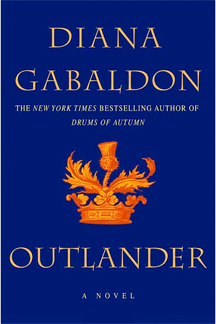 Cards on the table, I am a bibliophile if there's ever been one.
Cards on the table, I am a bibliophile if there's ever been one.Ever since reading my first chapter book (which happened to be the first of the Babysitters Club Book Series, if you're wondering) I have been head over heels with the written word. Books, whether they be fiction, inspirational, historical, biographical, or what have you, are completely inspiring, transformative, and fulfilling and such a huge part of me. The only thing I'd wish for would be an environment with like-minded individuals with whom to discuss whatever tome I am most likely to be found obsessing over! With that said, I figure maybe I should take it upon myself to make it happen. Hopefully, one of you out there will be reading this and inclined to reply!
So, Outlander. Had to do it. Had to read it. I regret nothing.
Typically if there is ever a film or television interpretation of a book, I tend to rush and read it and this was no exception. For those who may not be aware the Starz network has filmed a cable show based on Diana Gabaldon's series, of which the first episode was aired last Saturday (new episode out tonight, guys!). My thing is this: movies and series don't usually measure up to their written counterparts and I like to give myself the opportunity to imagine the worlds these works take place in before all I can see is the actors' interpretations.
Let me just begin by saying that romance novels and science fiction are usually not my things. I still haven't finished The Hobbit and I started over ten years ago. But ladies and gents, this book melds these two genres surprisingly well! (Additionally, throw in some fantasy and historical background and BOOM, you pretty much get this in the cauldron.) Outlander is a novel about a nurse named Claire Randall (née Beauchamp) in the 1940s on vacation in Scotland with her husband after the conclusion of WWII before finding herself sent back in time about 200 years to a period just before the Jacobite Rebellion. Yup, that's what happens. Right of the bat, I wondered what would have to happen to make this believable to me. I would probably never have been tempted to read something like this were I not prompted by a small screen deadline, but I am very happy I did.
To me, the best thing this novel had going for it was the complexities of the characters and the way they fully came to life through Claire's words. Because this novel was written in the first-person perspective, we really got to know and learn about the characters as you would people you met in your personal life: slowly and deeply. Finding herself in 1700s Scotland, Claire meets a young lad by the name of Jamie Fraser with whom she becomes instantly attracted to. When Claire realizes that she might be developing feelings for him it is no surprise to the readers because most likely they have also begun to feel them as well! Claire, Jamie, and the rest of the characters (there are quite a few!) are very dynamic and multileveled, never ceasing to surprise as to why they are the way the are or why the act the way they do.
While I don't want to get too deep into this or too detailed, I will say that the ending will keep you wanting more. More of Claire's story. More about the background characters' stories. More of Scotland's story. And definitely more salacious nights with Sir Fraser. It is part romance novel, after all.
To wrap this up, I'll include a link to a song that encompasses the feeling of this novel to me. The magical sense that I imagine would come from being in the Scottish highlands at that time, under the circumstances that Claire does. This song, "Figlia de la Luna" by Highland, also reminds me of a scene from the novel in which Claire and her modern-day husband, Frank, witness in the middle of the night as a coven of Pagan worshippers complete a ritual of theirs. If you've read the book, you'll know what I'm talking about. If you haven't, maybe this will peak your interest. It's really magical.
Highland - Figlia de la Luna





